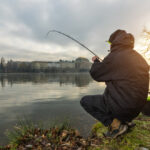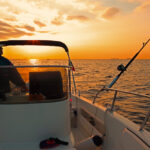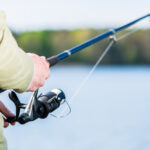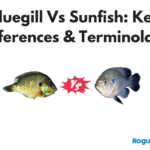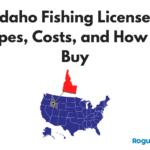There are several things you need to remember to pack when you’re preparing for a bass fishing trip. You need a strong rod and some durable fishing line.
But what about your bait? Bass has a pretty varied diet, but it’s important to know what food will lure them towards your hook.
So, what do bass eat? Generally speaking, they’ll eat anything that doesn’t eat them first! But that doesn’t necessarily mean that they’ll be drawn towards anything you cast into the water.
Below, we’ll take a look at a bass’ natural diet and what they eat throughout the different seasons. We’ll also explore the foods that each bass species eat, helping you get a better chance of getting that perfect catch.
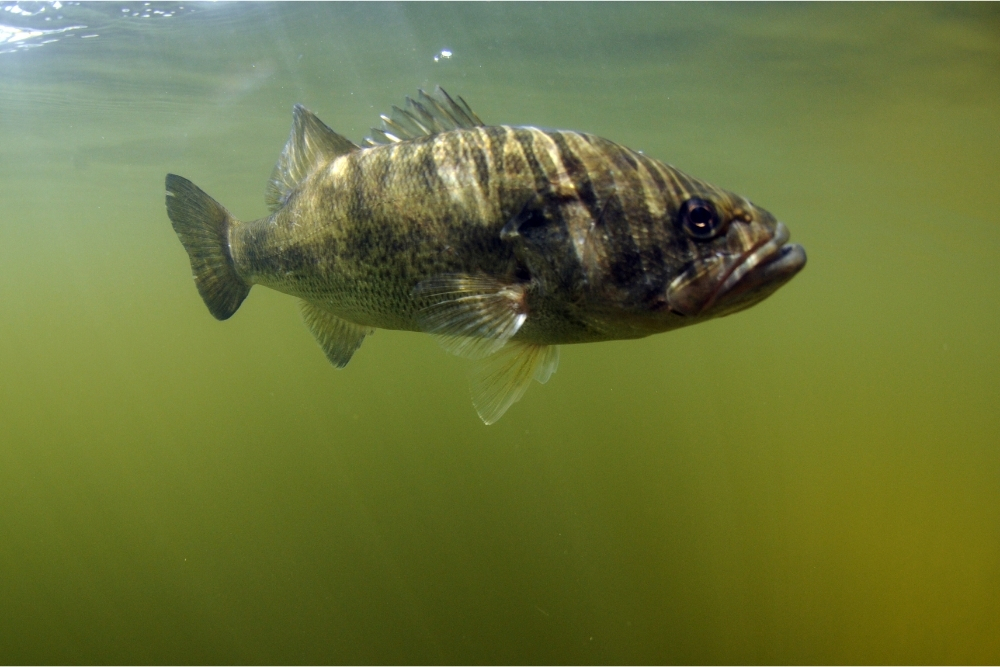
The Bass Diet: Key Information
To increase your chances of catching any bass species, you need to understand what they eat and what is most likely to tempt them.
As we’ve mentioned above, bass eat a varied diet, and, as they are usually the apex predator in their environment, they’ll eat anything smaller than them to keep the food chain in order.
Put simply; they survive by dominating the weak. So, whether their habitat is a lake, river, stream, or reservoir, an adult bass will feed on various smaller fish such as minnows, sunfish, and perch. And, if other food sources are scarce, they’ll even eat each other!
A bass diet isn’t fish-specific, though. If a bass can fit something in its mouth, it’ll eat it! They’ll also eat frogs, insects, crayfish, and some species will even eat smaller aquatic birds. Lizards, snakes, baby ducks, and eels have also been found inside a bass stomach before.
The only exception to these feeding habits is bass “fry.” This refers to bass that are under two inches in length.
Bass fry doesn’t exhibit predatory behavior in the same way that adult bass does and; instead, they’ll feed on insect larvae and plankton. They’ll continue with this limited diet until they are big enough to hunt bigger food.
Something else that is particularly useful for any bass fishermen to know is that the way a bass eats is an indicator of the health of their population.
If the waters are teeming with large numbers of bass, there will be a rich ecosystem. This means that any bass caught in this environment will be strong and healthy.
Seasonal Eating
The common motivator in a bass’ feeding habits is survival. As we’ve already said, they are extremely opportunistic eaters who will feed on anything smaller than them. And, the bigger the bass is, the larger the animal it will be able to hunt and eat.
However, this doesn’t necessarily mean that a large bass only seeks out large prey. Experts have noticed that there does seem to be a preferential food source for bass and its soft-bodied fish.
So, if you’re looking for a way to increase your chances of catching bass, using something like the spineless threadfin shaft as your bait (find the best buzzbait for bass here) is a good choice.
But do bass’ feeding habits change throughout the seasons? Not really. Instead, they rely on year-round available food sources as their staple diet and will eat other animals around this.
Insects and their larvae are always on the menu for bass, especially for bass fry, who need to eat as much as possible to get to adult size. Plankton is another year-round food source for young bass and, during the summer months, plankton comes as a useful hunting tool for adult bass.
This is because the plankton population increases by huge numbers during the summer, and, as it does, smaller fish are drawn to their waters to feed on it. The population of these smaller fish grows as a result, and, as their population grows, more of an adult bass preferred food becomes available.
Eating to Survive
So, we know that adult bass has a preference for smaller, soft-bodied fish. But this isn’t because they find the taste of the texture irresistible. It’s simply because they contain the nutrients, vitamins, and minerals that bass needs to grow strong and healthy.
They also seem to go for certain species of soft-bodied fish, depending on their nutritional value. For example, it has been noted that bass will choose to eat a madtom, which is a smaller member of the catfish family, over other soft-bodied species. This is because they contain a higher level of vitamins and minerals that bass needs to survive.
Bass also have no fear of attempting to eat something that looks out of place in their natural environment. Part of this is because they are naturally curious fish and want to get up close and inspect anything that might seem foreign in their water.
But defense also plays a part in this. Basses want to keep their place in the food chain, and anything that threatens that simply needs to be shown who’s boss by eating it!
Different Bass Species Have Different Diets
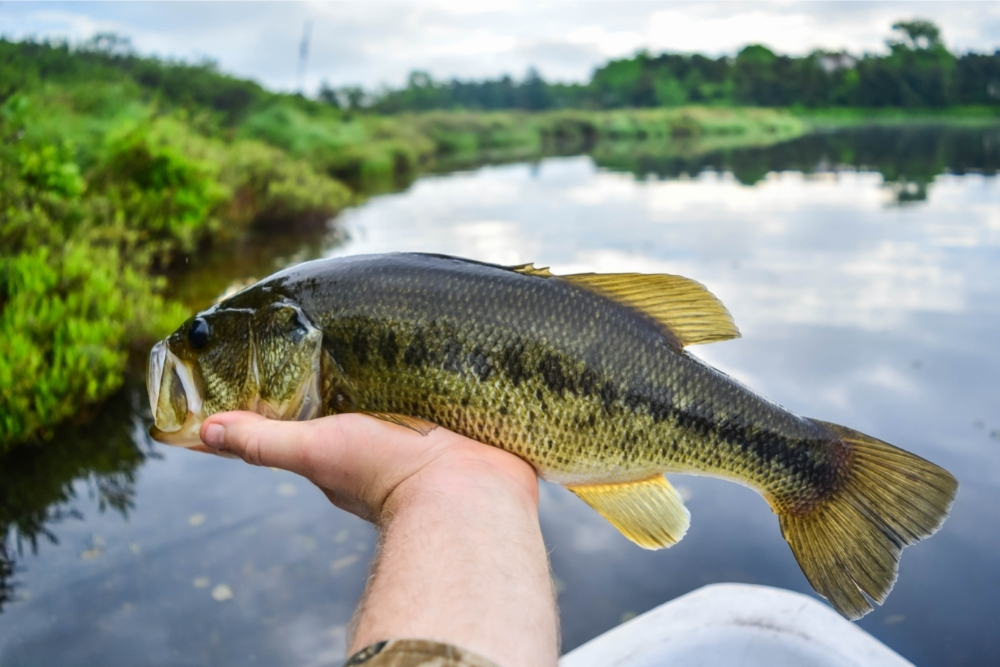
The diet of bass changes as they grow from fry into adult fish. But what a bass eats also depends on the species. Below, we’ll look at the differences and similarities between what a largemouth bass and a smallmouth bass eats.
Both species are predatory and will happily take on whatever they believe they can fit into their mouths, but there are certain things that each species won’t attempt to eat.
The Largemouth Bass Diet
Largemouth bass has an attuned sense of smell which, when paired with their impressive strike speed, makes them highly efficient hunters. They’ll often lurk in between rocks, grass, or the roots and limbs of a sunken tree, where they will wait for their prey to pass by.
As is the case with both bass species, largemouth bass will go after anything that it feels it can confidently catch. However, there are some things that they won’t attempt to hunt as they are bigger than themselves.
This includes pike, walleye, and muskie. In fact, for these fish, largemouth bass is often their choice of food if they can’t find something easier to feed on nearby. In this instance, the largemouth bass will use its predatory-style hunting technique to find shelter instead.
The Smallmouth Bass Diet
Smallmouth bass is most commonly found in clean, fast-moving waters such as rivers and streams, which largemouth bass tend to stay away from. This gives them a monopoly over certain foods, which, in turn, helps their population grow.
The different waters that smallmouth bass and largemouth bass reside in also mean that there is a bit of a difference in what they eat.
In colder waters, particularly during winter and fall, you’ll find smallmouth bass feasting on the abundance of crayfish that live in the same waters. Insects are a popular food choice, too, especially in waters that have a current running through them.
Another thing that sets both species’ feeding habits apart is that smallmouth bass that lives in fast-moving water will change their hunting style. Rather than using rocks, grass, and sunken trees, and a place to strike from, they will turn into cunning bottomfeeders.
They’ll turn over rocks and other obstacles in a bid to reveal and shake out crayfish, insect larvae, and anything else that might be using them as cover. During the summer months, you’ll also see smallmouth bass using this technique to feed on prey that lives in between rocks, such as darters and sculpins.
Diet According to Habitat
As we’ve mentioned above, bass feeding habits have a lot to do with the habitat they live in. Bass that live in lakes, reservoirs, and large open bodies of water will have a much broader diet than those that live in smaller or fast-moving bodies of water. This is simply because the larger bodies of water provide a greater variety of prey.
The diet of bass will also be determined by the area they live in. Bass that live in colder, northern waters will feed on smaller fish that thrive outside warmer climates. Whereas those that live in southern waters will eat crayfish, worms, insects, and anything else that prefers warmer temperatures.
Bass will generally eat whatever is native to the waters they live in, as long as it’s smaller than them. This adaptability has seen bass populations grow so healthily, making them one of the most popular game fish in the world.
Choosing Your Lure Based on Feeding Habits
Now you know what each species of bass eats, as well as what is most likely to seem familiar to them in their environment. But how can you use this information to your advantage when you’re fishing for bass?
To begin with, understanding how a bass feeds can help you tailor your lure and line to bring in more fish and increase your chances of getting a catch. Since we know that bass are predatory hunters, using a lure body or trailer resembling something living would make sense.
It would also be advantageous to model your lure on what the bass would be naturally feeding on at that time of year and the small soft-bellied fish available in those waters. They’ll see this as a prime opportunity to strike.
The best thing to do to increase your chances of catching bass is to research the waters that you’re planning to fish before you start fishing. Take a look at what other fish you can see in the water, ask any other fishers how their bass-catching success rates have been in that area.
It’s also worth checking out the water type, conditions, and temperature. By doing this, you can create a lure that mimics prey that the bass is currently feeding on.
If you’re fishing in fast-moving waters, you’ll need a heavier line that will be able to keep your lure secure and prevent the water from giving an unnatural movement. You’ll also need to use a lure that fits a heavier line, which does limit your choices somewhat.
You’ve got a few more choices when fishing in still waters, though. Lures such as jigs, crankbaits, soft-body worms, and tubes are also good choices. You’ll just need to experiment with different lures until you find something that works successfully.
If you’ve noticed the waters you’re planning to fish in are home to smaller fish, such as minnow or shad, then it makes sense to use a lure that mimics these species. This is especially useful in warmer waters. However, if you’re fishing in colder waters, a lure that mimics a crayfish or a worm would be a better choice, as this is what the bass will naturally be hunting.
To put it simply, you can increase your chances of catching bass by matching your lure to the bass’s natural food source. If it looks and moves like real prey, they’ll be much more likely to strike.
It’s also a good idea to plan your fishing trip for the morning or evening. Bass are much more active outside of the hottest hours of the day, and they’ll choose these times to feed; this is the case for both bass species and in all water conditions.
What if the Bass isn’t Biting?
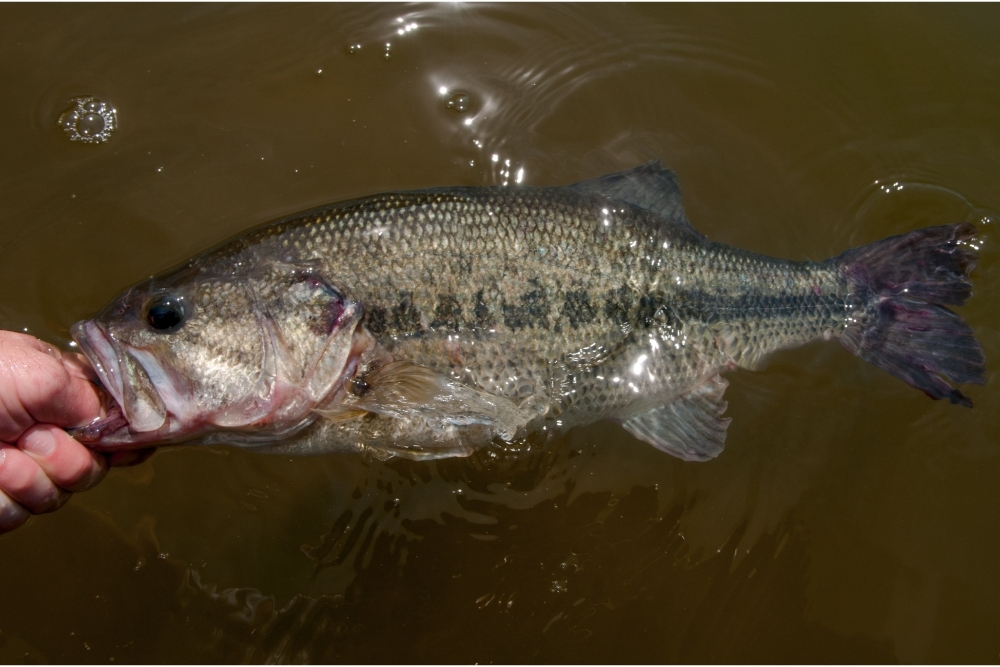
If you’ve done all of your research and you’re using a lure that mimics a bass’ natural food source for that time of year, but you still can’t get a bite, there are a couple of tricks you can try.
The first is to try using a lure that is a little more ‘out there.’ Remember that bass will confidently confront anything it considers to be foreign to its environment as a way of defending itself. So, using a lure that is vibrantly colored. Multi-jointed or has a wide trailer could catch their natural curiosity.
Secondly, give some thought to your technique. If you’re power fishing in quiet waters, the fish will be easily spooked and will seek cover rather than being enticed by your lure. In this instance, the best course of action would be to change your tactics rather than the type of lure you’re using.
A bass motivation to strike on a lure is only as good as your motivation to get them to bite. So if you find yourself having little success, to begin with, change your tactics.
The time of year is another thing to think about if you’re not having any success with bass fishing. Bass tend to pre-spawn in the spring when water temperatures have started rising, so it might be that you’re fishing in a season where few basses are present in the water.
Waiting until summer is your best bet here, as spawning will be coming to an end, and the bass will be feeding at an increased rate.
Final Thoughts
If there’s one thing you need to remember when it comes to bass fishing, there are no set rules. This is what makes it so much fun!
As the bass isn’t particularly fussy about what they eat, you can try a variety of different lures until you find one that works for you. You might even find that switching between different lures between catches works as a good tactic.
It is worth, however, doing a little research on the fishing waters ahead of your trip. While we know that the food preferences between largemouth and smallmouth bass aren’t that different, we know that their environment determines their available food source.
Choosing a lure that mimics something that a bass will be interested in eating will increase your chances of getting a catch. And, if all else fails, play to a bass’ natural curiosity by using a lure that mimics something that looks out of place in those waters.
